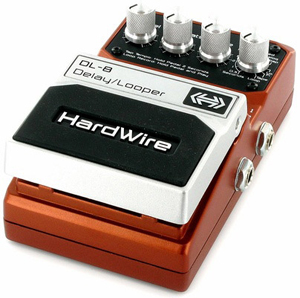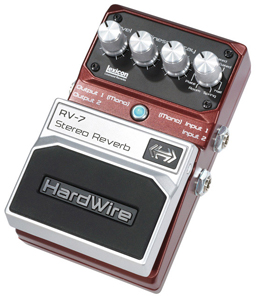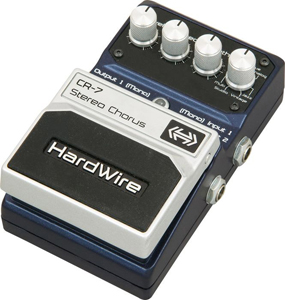Hardwire Guitar Pedal Series: The DL-8, RV-7 & CR-7 In Review
By Howard Stock, for Delicious Audio
Right out of the box, you can tell the folks at Hardwire know what it’s like to schlep gear to some sticky dive bar with a stage so dark you can’t see your strings.
They throw in extras that don’t have to, such as a fluorescent sticker that you can stick on the toe switch for blackout gigs, a rubber cover that fits over the knobs when you’ve got them where you want them — a particularly good idea for delay pedals where only one combination of settings will do — and they even include a made-to-measure Velcro cutout to attach it to a pedal board.
Even the battery compartment is designed with the minimum of fuss. The pedals are also handsome in their metallic paint jobs, knurled aluminum knobs and (mostly) blue LEDs. But as the saying goes, it’s what’s inside that counts.
DL-8 Delay
The DL-8 does a ton of stuff that’s really fun if you’re playing by yourself, and you can easily lose hours monkeying around making space noises and using the 20 seconds of loop memory to lay down a groove. It’s by far my favorite of the Hardwire line.
Look at the options: you’ve got anywhere from 0.5 seconds to one, two and eight seconds’ delay, a reverse mode that’s just plain spooky, modulated, analog, a useful slap mode, grainier lo-fi and tape modes and then loop, which is so straightforward Hardwire prints the instructions on top of the pedal—Loop Record: Hold Pedal and Play.
The DL-8 also features tap tempo for intrepid guitarists who manage to break free of this tar pit of self-indulgence and actually make it to rehearsal where they’ve got a drummer to coordinate with. As with Hardwire’s other delay effects, the DL-8 features dual inputs and optional stereo output.
Playing alone and jacking up the levels, this pedal is incredibly inspiring, but like all delay pedals, it takes a great deal of discipline to use this wisely in a band setting. Luckily, the controls and the thoughtful design of the different modes means that guitarists with a light hand can quickly dial in useful delays, from U2 atmospherics to jumpy rockabilly slap back. The best effects inspire guitarists to explore creative directions they wouldn’t have discovered otherwise, and the DL-8 is definitely one of those pedals.
RV-7 Reverb with Lexicon Reverb
The promotional materials for the RV-7 regularly and enthusiastically tout Hardwire’s partnership with Lexicon, a company that makes top reverb rack effects and software. The result is a pedal crammed with seven different synthetic reverb modes. Reverb is a tricky effect—unless you’re going for all-out surf madness, you just want it to insinuate itself into your sound by adding a godlike resonance to your noodling.
The RV-7 offers plenty of options for fans of both and throws in what the other similar pedals lacks, a reverse reverb mode. Hardwire’s RV-7 digitally models vintage favorites plate and spring reverb and adds room and hall modes for those looking to replicate the sound of an empty venue. The pedal also includes gated reverb, modulated reverb, which swirls a bit, and, of course, reverse reverb, which is intriguing but difficult to put to any practical use due to the effect’s odd time lag.
The RV-7 does jacked-up ghostly sustains very well without sounding inorganic, but politely takes a back seat when it’s set to more subtle levels and familiar modes, while offering dual inputs and stereo output. While there’s no replacement for a great reverb tank, Hardwire’s RV-7 brings realistic reverb and a ton of options for players who want more control than the real thing is able to offer.
CR-7 Chorus
Hardwire’s delay pedals are extraordinarily versatile, and the CR-7 is no exception. Chorus, an effect that is by no means loved by all, at least benefits here from its seven different modes. The differences between them are basically warmth and clarity.
The studio mode, for example, has heaps of the latter, but sounds a little sterile as a result. One would imagine the modes would get less clear and more warm as each clockwise twist of the mode knob takes the pedal into vintage territory, but it’s not the case.
The quirkiest one is boutique, right at 12 o’clock, which has a pleasant warmth but the chorus’s warble sounds fake and digital. But far the most aurally satisfying is the gorgeous jazz mode, which manages to sound more vintage than the vintage mode, and is so much warmer.
For stage use, though, I’d stick to the studio, multi and modern modes. Analog and vintage shoot for old, but neither does it as well as jazz, and the boutique mode falls well short of all the others. The pedal’s speed and depth controls are very responsive and allow a great degree of sonic shaping, and the pedal offers two inputs and two outputs, so if you use two amps or want to combine wet and dry input signals there are plenty of options.
In short, if you want a chorus stomp, the Hardwire contains several very good options in a single pedal. The Hardwire line also features a Tremolo, Metal, Valve Distortion, Overdrive and Tuner pedals.
— by Howard Stock, for Delicious Audio.
Please note: When you buy products through links on this page, we may earn an affiliate commission.









